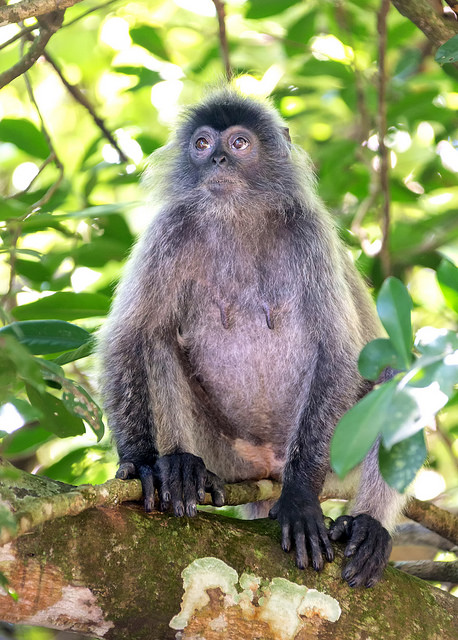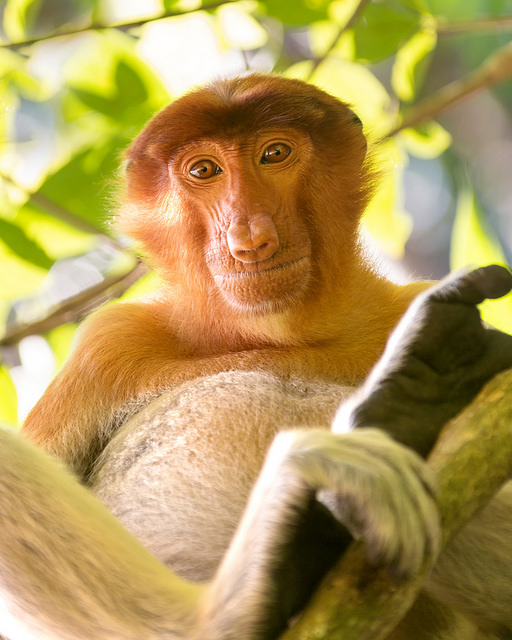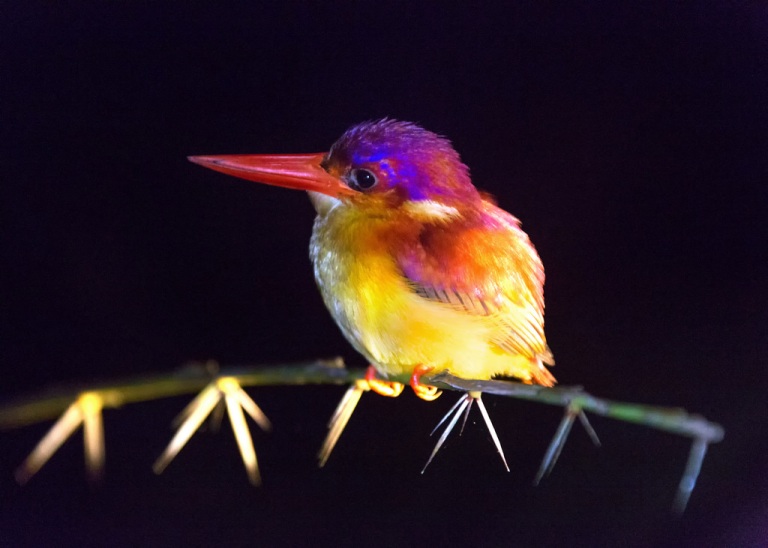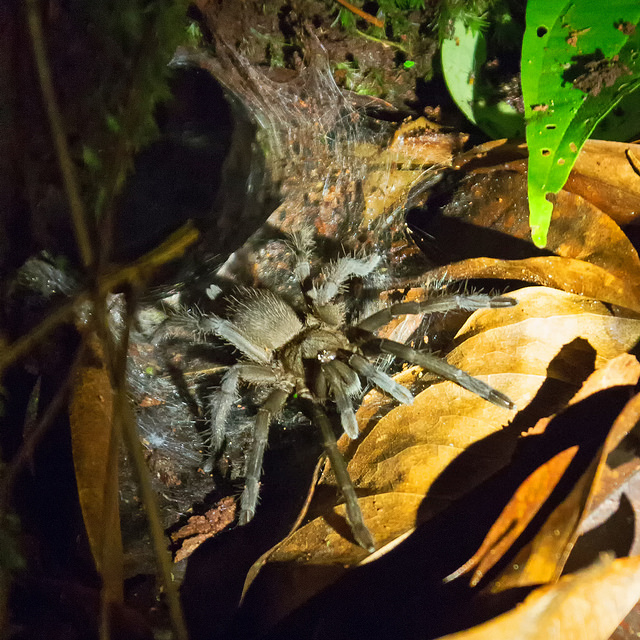Bako was the first National Park in Malaysian Borneo. Only 25 miles northeast of Kuching, it sits on a small peninsula that juts into the South China Sea. Bako has no roads, so to get there from Kuching I caught a bus to a nearby village where a boat service ferries people the rest of the way.
Halfway to Bako our boat ran aground on a mud bar. The tide was very low and the water in the channel we were navigating was only a few feet deep. “Can we get out and push?” someone asked the driver.
“No,” the driver answered. “Too dangerous. Stingrays.”
So we just sat there. Fishermen sped by and waved. Finally another park boat slowed down to talk to us, but the two drivers agreed that we were simply stuck until the tide rose. That prompted several of the passengers to make what seemed like an obvious suggestion: “Can’t we just send a few people to the other boat, which might lighten up our boat enough to get it loose, and then bring everyone back on board?”
The drivers were skeptical of this apparently novel idea, but they agreed to try it. A few minutes later our boat was free and we were on our way to Bako again. It was an unusual episode. Locals are almost always better problem-solvers in their area of expertise.
Bako’s headquarters and surrounding facilities are built on flat, somewhat swampy ground just behind a stretch of beach. The tide was too low for us to use the boat dock, so the driver took us as close to the beach as he could and we waded ashore. I registered at the park HQ and headed out for a hike.
As I left HQ one of the boat drivers called over, “Do you want to see a proboscis monkey?” Proboscis monkeys are Bako’s best-known wildlife, and they often hang out in the trees that line the main beach. People said the odds of seeing a proboscis monkey were good, but a sighting this early in my visit would be a great sign. The driver pointed to the high branches of a large tree in front of HQ. And there it was! I could see the monkey’s huge nose flopping up and down as he chewed on a leaf.

Proboscis monkeys are found only in Borneo. Classified as endangered, they’re considered at risk of going extinct. There are only about 7,000 left, with 200 or so in Bako. The males have bulbous, oversized noses and big pot bellies, and they communicate with an unusual honking sound that makes them seem even more clown-like. I watched the one in the tree for a while and then started my hike.
I hadn’t even made it to the boat dock when I ran into a troop of macaque monkeys sitting on a bridge railing. Macaques are much more common – and much more comfortable being around humans – than proboscis monkeys, but for me it’s still a thrill to be able to watch them up close.


As I took photos of the macaques a bunch of proboscis monkeys passed through the trees overhead. Monkeys everywhere! It felt like I was inside a zoo exhibit. Some of the proboscis monkeys dropped down low enough for me to get a sense of how big they are. It’s not unusual for males to weigh 50 pounds.

After all the wildlife around HQ, the short Paku Trail hike was anti-climactic. I was carrying my full backpack, and within 10 minutes I was sweating as badly as I had at Kubah. Near the end of the trail I passed another group of proboscis monkeys high in the trees.




Back at HQ I ate lunch and checked into the room I’d booked for the night. All of Bako’s lodging is extremely basic. My room contained four single beds, four pillows, and a fan. Given the setting, it felt luxurious. I would have been happy sleeping on the ground.
That afternoon I did another relatively quick hike to the end of the Delima Trail, but I spent most of my time walking along the paths near HQ, where there was almost always some kind of wildlife. Before too long I encountered the park’s third monkey species, the silvery langur (sometimes called silvered leaf monkey or silvery lutung). They were the shyest of Bako’s monkeys.



I also ran into some of the bearded pigs that rooted around the ground near the main beach. They were totally accustomed to the presence of humans.


Late in the afternoon I walked over to the boat dock to photograph the sun setting behind a group of dead trees. The trees had grown on a mud flat that was submerged during high tide, but the tide was out when I arrived and the silvery langurs were crossing the flat. I noticed that one of the black and gray langurs was carrying some kind of bright orange bundle, which turned out to be an impossibly cute baby langur.




The next morning I woke up before sunrise and headed out for photos, assuming that the animals would be more active at dawn. But the there wasn’t much happening. As I ate breakfast a few drops of rain suddenly turned into a torrential deluge that lasted a half hour. When the storm passed a rainbow appeared, right on cue.

After checking out of my room I decided to try the Kecil Trail. The three-hour roundtrip hike led to a beach with a view of Bako’s most iconic landmark, a curved sea stack. The recent rain had flooded the trails and I was glad I’d chosen to wear my waterproof sandals instead of hiking shoes.


Again I didn’t see much wildlife on the trail, but back near HQ I came across several different groups of proboscis monkeys, including moms with babies.



I returned to Kuching that afternoon. But I hadn’t had enough of Bako. I wanted another round. So after a day of working on photos I went back to the park for a second overnight stay. This time our boat made it all the way without incident.
I felt like I’d paid my dues on the trails, so my plan was to just roam around HQ photographing wildlife. I was especially hoping to get closer to the proboscis monkeys, who tended to stay in the treetops. I also wanted better shots of the proboscis babies. Almost immediately I had good luck.


Patience was key. If I spotted a group of proboscis monkeys and followed them long enough, they almost always dropped down from the treetops. And if I was quiet and made no sudden movements they let me get pretty close. Some of the moms even left their babies in plain view.






After dinner I joined the ranger-led night hike, something I’d skipped during my first visit. Almost immediately the ranger pointed out a green pit viper in a bush near HQ. A 20-something woman in our group kneeled right in front of the viper for a selfie. “That is not a plastic snake,” warned the ranger. “It is dangerous.” The woman either didn’t hear him or didn’t care. He shrugged. I wondered if anyone in the group had ever heard of the Darwin Awards.




Dawn the next morning was disappointing in terms of wildlife activity, just as it had been on my first visit. The monkeys eventually made an appearance, and I was able to find the pit viper again. One of the boat drivers pointed out an even bigger viper in the same bush.



While I was eating lunch an American in his 50s came back from an outing with his guide and joined his wife at the table next to me. He was visibly upset. “Why can’t you push yourself just once?” he barked at his wife in a loud, angry voice. Apparently their guide had proposed a short hike to look for proboscis monkeys and the wife was too hot and tired to go. The husband went anyway and, assuming they’d only see monkeys from a distance, he left his camera with his wife. But in the middle of the hike a proboscis monkey dropped down in front of him, providing the photo opportunity he desperately wanted. “It was a once in a lifetime deal,” the husband whined. “None of this up-in-the-treetops shit. The thing was right in front of us!”
Best I could tell, the husband was blaming his wife for the missed photo because if she’d had the energy to join him he wouldn’t have had the option of leaving his camera with her. It didn’t make much sense to me, nor did it to the wife. She weathered his increasingly bitter ranting like a mother dealing with a spoiled child, patiently pointing out that he was the one who decided not to take his camera, and that he should be happy – not angry – to have had such a close encounter with the monkey.
The exchange made an impression on me, I think, because I recognized too much of myself in the unhinged husband. I can fully relate to the anguish of missing a perfect photo opportunity. It burns. I get why the husband was upset. But wow, letting that send you into an angry spiral that ruins your day (maybe your whole trip) and causes you to lash out irrationally? Ridiculous on many levels. It was a good reminder to keep the photo stuff in perspective. (Admittedly though I was still tempted to tell the monkeys to cool it with all their up-in-the-treetops shit.)
Bako had been amazing and I was sad to leave. I spent another day in Kuching before flying back to Kuala Lumpur. Two months ago I’d never even heard of Kuching, and now it was my favorite city in Malaysia. But I’d only explored a tiny fraction of Borneo. At some point I’d like to see more.


Hi there,
I’m Ryan Fidelis from MullenLowe Malaysia, an advertising agency.
On behalf of my client Malaysia Airports Holding Berhad, they have a website under their roof which is http://flyklia.com/ (FlyKLIA.com). It is a social network for travelers.
Just to inform, one of the features on the website is that it has curated content on destinations around Malaysia and also overseas. Nevertheless, we are very interested in featuring your article on Bako National Park, Malaysia dated on April 20th 2016.
We will feature your name on the website article once permission is granted from your end.
Hope to hear from you soon and please do not hesitate to contact me if there are any queries.
Thank you,
Ryan
LikeLike